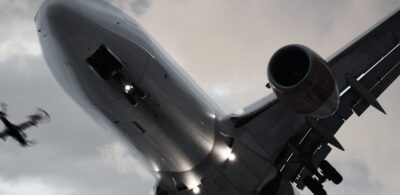Is it a bird, is it a plane? Airtaxis set to take off in Brisbane
14 February 2023
The 10 year countdown is on to the 2032 Olympics, and Brisbane has launched a radical transportation strategy. The plan is for airtaxis to become part of Brisbane’s ‘aviation ecosystem’ in time for the 2032 Olympics. With a growing appetite from industry to get in the air, the regulatory framework will need to develop at a fast pace to sure up investment in the Australian market.
What are airtaxis?
Airtaxis, or vertical take off and landing vehicles (VTOL), look like a cross between a helicopter and a drone. They are electric or fuelled by hydrogen, and while some are designed to fit a pilot, others are autonomous with human supervision. The idea is that a passenger can travel to a ‘vertiport’ and take a short flight on demand – like a flying taxi.
There have been various announcements about establishing airtaxis in Queensland in time for the Olympics, with key players being Wisk Aero and ASML Aero. Skyportz also intends to build an airtaxi also intends to build an airtaxi take off and landing hub in Moreton Bay at the Australian Advanced Manufacturing Centre of Excellence (AAMCE). There is no doubt an appetite to live out the Jetson’s vision of 2060 within the next 10 years, but will the regulatory space be ready for airtaxis?
Market disruptors
While Brisbane’s local government, as well as the Civil Aviation Safety Authority (CASA), have embraced the concept of an airtaxi ecosystem in the long term, the technology is not far from deployment. In late 2021, France started testing airtaxis in preparation for the 2024 summer Olympics. Since then, the Pontoise-Cormeilles first-of its-kind vertiport opened in November 2022 to support airtaxis delivering three trips an hour across Paris by 2024. Other population dense cities with traffic issues, including Los Angeles, São Paulo and Singapore, are at the forefront of airtaxi infrastructure development with developers expecting to be safety certified by 2025.
When rideshare giant Uber entered the Australian market in 2012, the regulatory lag around Uber’s legality lead to uncertainty. With the current amount of enthusiasm and investment going into airtaxi technology, it is not outside the realm of possibility that a company might be ready to deploy the technology before the regulatory framework is in place.
So, if an airtaxi was to operate in Brisbane tomorrow, how would it be regulated?
It’s a drone
Given that Wisk’s airtaxis will operate without a pilot in the aircraft like a drone, they may fall into the characterisation of a Remotely Piloted Aircraft (RPA) under Part 101 of the Civil Aviation Safety Regulations 1998 (Cth) (CASR). Drones are regulated according to size. An airtaxi would be classified as a large RPA given they will have a gross weight of more than 150 kg (Wisk Aero’s airtaxis are 1270 kg).
The CASR are very prescriptive in relation to the operation of large RPAs. Specific CASA approval is required for most operational aspects, from remote piloting air operators certificates (101.270), certificates of airworthiness (101.255) and remote pilot licences (101.252). On the safety aspects, specific approval from CASA is required for operation of large RPAs over a populous area (101.280). Various penalties apply for a failure to comply with these CASA approvals.
However, the ‘glitch’ in the regulatory framework is that the CASR do not contemplate an RPA carrying passengers.
It’s a helicopter
The fact that airtaxis carry passengers means they appear to better fit with CASR regulations on helicopters, however, airtaxis break a fundamental presumption of helicopter regulation: that there is always a pilot in the aircraft.
Airtaxis and their civilian passengers will not be subject to many of the helicopter flight rules which only apply to pilots, and not aircraft operators. For example, under current flight rules, the pilot commits an offence if the helicopter is flown in a restricted area or below the minimum height specified (91.260, 91.265). Remotely piloted, or autonomous, airtaxis likely fall outside the scope of these rules.
It is also unclear how the risks of collisions will be managed. A transponder is a device that enables aircraft to be detected by air traffic control and other aircraft to prevent collisions. Under the current rules, whether a transponder is required appears to depend on the pilot’s choice of flight rules (either visual flight rules or instrument flight rules). While possible the rules could extend to a remote pilot, it is unclear what will apply particularly given that airtaxis are likely to be operating in “uncontrolled airspace”, being below the height of planes (under 2500 metres) and away from airports.
It’s an airtaxi
CASA has acknowledged that airtaxi regulation will require a bespoke approach. In July 2022, CASA released a Strategic Regulatory Roadmap (Roadmap) outlining its approach to aviation safety regulations for drones and advanced air mobility (AAM) over the next 15 years. The Roadmap highlights that:
- regulations will need to licence airtaxi ‘dispatchers’ rather than pilots;
- significant investment needs to be made in developing appropriate safety regulations, but also in infrastructure and traffic management systems; and
- any regulations need to be in harmony with regulation in other jurisdictions.
The need for speed
McKinsey predicts that by 2030 the leading companies in the airtaxi industry could have bigger fleets and offer more flights per day than major airlines, at least in the US. However, it appears from the CASA Roadmap that CASA aims to have addressed certification standards, designed air traffic management for vertiport operations and made the required changes to safety regulations under Part 101 of the CASR by 2031.
The question remains: how can the regulatory framework quickly adapt to meet the speed at which the airtaxi technology is being adopted and the commitments made to showcase a new mode of transport for the Olympics, all the while keeping public safety at the forefront?
Authors

Partner
Lawyer
Tags
This publication is introductory in nature. Its content is current at the date of publication. It does not constitute legal advice and should not be relied upon as such. You should always obtain legal advice based on your specific circumstances before taking any action relating to matters covered by this publication. Some information may have been obtained from external sources, and we cannot guarantee the accuracy or currency of any such information.



